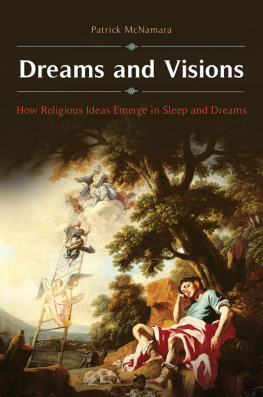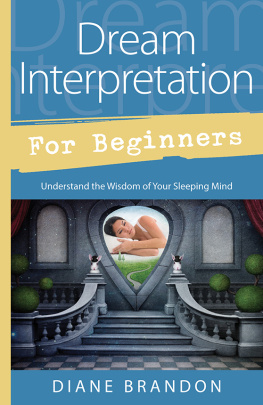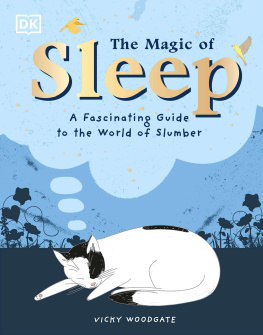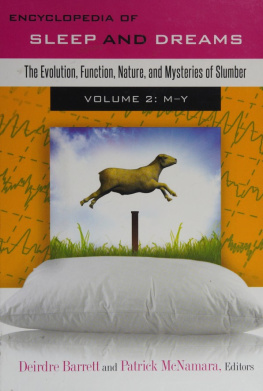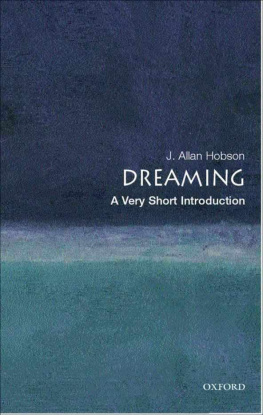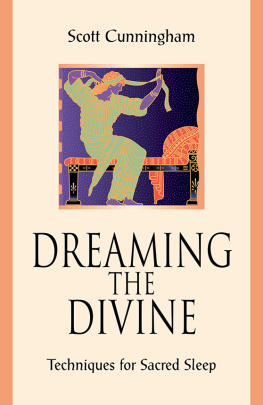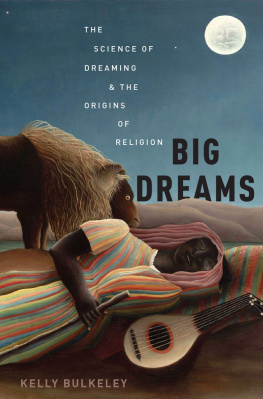Dreams and Visions
Recent Titles in Brain, Behavior, and Evolution
Nightmares: The Science and Solution of Those Frightening Visions during Sleep
Patrick McNamara
Dementia
Patrick McNamara, Editor
Analyzing Criminal Minds: Forensic Investigative Science for the 21st Century
Don Jacobs
Spirit Possession and Exorcism: History, Psychology, and Neurobiology
Patrick McNamara
Science and the Worlds Religions
Patrick McNamara and Wesley J. Wildman, Editors
Beast-People Onscreen and in Your Brain: The Evolution of Animal-Humans from Prehistoric Cave Art to Modern Movies
Mark Pizzato
Dreams and Visions
How Religious Ideas Emerge in Sleep and Dreams
Patrick McNamara
Brain, Behavior, and Evolution
Patrick McNamara, Series Editor

Copyright 2016 by Patrick McNamara
All rights reserved. No part of this publication may be reproduced, stored in a retrieval system, or transmitted, in any form or by any means, electronic, mechanical, photocopying, recording, or otherwise, except for the inclusion of brief quotations in a review, without prior permission in writing from the publisher.
Library of Congress Cataloging-in-Publication Data
Names: McNamara, Patrick, 1968 author.
Title: Dreams and visions : how religious ideas emerge in sleep and dreams /
Patrick McNamara.
Description: Santa Barbara : Praeger, 2016. | Series: Brain, behavior, and evolution |
Includes index.
Identifiers: LCCN 2016022793 (print) | LCCN 2016027048 (ebook) |
ISBN 9781440847165 (alk. paper) | ISBN 9781440847172 (ebook)
Subjects: LCSH: DreamsReligious aspects. | SleepReligious aspects. | Visions. |
ReligionPhilosophy.
Classification: LCC BL65.D67 M36 2016 (print) | LCC BL65.D67 (ebook) |
DDC 204/.2dc23
LC record available at https://lccn.loc.gov/2016022793
ISBN: 978-1-4408-4716-5
EISBN: 978-1-4408-4717-2
201918171612345
This book is also available as an eBook.
Praeger
An Imprint of ABC-CLIO, LLC
ABC-CLIO, LLC
130 Cremona Drive, P.O. Box 1911
Santa Barbara, California 93116-1911
www.abc-clio.com
This book is printed on acid-free paper 
Manufactured in the United States of America
Dedicated to Ina McNamara
Contents
Beginning in the 1990s, behavioral scientiststhat is, people who study mind, brain, and behaviorbegan to take the theory of evolution seriously. They began to borrow techniques developed by the evolutionary biologists and apply them to problems in mind, brain, and behavior. Then, of course, virtually all behavioral scientists up to that time had claimed to endorse evolutionary theory, but few used it to study the problems they were interested in. All that changed in the 1990s. Since that pivotal decade, breakthroughs in the behavioral and brain sciences have been constant, rapid, and unremitting. The purpose of the Brain, Behavior, and Evolution series of titles published by ABC-CLIO is to bring these new breakthroughs in the evolutionary and brain sciences and their applications to the sciences and humanities to the attention of the general public.
In the past decade, some of these scientific breakthroughs have come to inform the clinical and biomedical disciplines. This means that people suffering from all kinds of diseases and disorders, particularly brain and behavioral disorders, will benefit from these new therapies. That is exciting news indeed, and the general public needs to learn about these breakthrough findings and treatments. A whole new field called evolutionary medicine has begun to transform the way medicine is practiced and has led to new treatments and new approaches to diseases, like the dementias, sleep disorders, psychiatric diseases, and developmental disorders that seemed intractable to previous efforts. In addition, evolutionary and brain approaches to the understanding of culture and cultural products in the creative arts have been appearing at an accelerating rate every year. The list of books in the Brain, Behavior, and Evolution series seeks both to contribute to this new evolutionary approach to brain and behavior and to bring the insights emerging from the new evolutionary approaches to psychology, medicine, and the creative humanities to the general public.
The Brain, Behavior, and Evolution series was inspired by and brought to fruition with the help of Debora Carvalko at ABC-CLIO. The series editor, Dr. Patrick McNamara, is the director of the Evolutionary Neurobehavior Laboratory in the Department of Neurology at Boston University School of Medicine. He has devoted most of his scientific work to the development of an evolutionary approach to problems of sleep medicine and to neurodegenerative diseases. Titles in the series will focus on applied and clinical implications of evolutionary approaches to the whole range of brain and behavioral disorders as well as the whole range of topics explored in the humanities. Contributions are solicited from leading figures in the fields of interest to the series. Each volume will cover the basics, define the terms, and analyze the full range of issues and findings relevant to the topic, which is the focus of the volume. Each volume will demonstrate how the application of evolutionary modes of analysis leads to new insights on causes of disorder and functional breakdowns in brain and behavior relationships as well as the creative cultural products of human ingenuity. Each volume, furthermore, will be aimed at both popular and professional audiences and will be written in a style appropriate for the general reader, the local and university libraries, and graduate and undergraduate students. The publications that become part of this series will therefore bring the gold discovered by scientists using evolutionary and neuropsychological methods to understand brain and behavior to the attention of the general public and, ultimately, it is hoped, to those families and individuals currently suffering from those most intractable forms of disordersthe brain and behavioral disorders. Evolutionary and brain approaches to the arts and humanities will also be part of this series and will undoubtedly illuminate the creative cultural products of artists/scholars in these interdisciplinary areas and even perhaps increase appreciation of the common artistic inheritance of humankind.
Many thanks to Chisom Chukwumerije, Luke Dietrich-Egensteiner, Victoria Pae, Adonai Sebastian, and Brian Teed for their help in preparing the references. Thank you to Paul Monroe Butler for comments on an earlier version of this manuscript. Thank you to my colleagues at Northcentral University for their support. Thank you to Nick Gibson of the Templeton Foundation for supporting cognitive and neuroscientific approaches to religion. Thank you to Wesley Wildman for years of fruitful and critical exchange of ideas on religion. Thank you to Dreamboard.com for allowing me to access its dream series data sets. Thank you to Debbie Carvalko, my longtime editor at ABC-CLIO, for supporting my work for many years.
One evening in the year 1743, a well-known and distinguished 55-year-old scientist was dining in a private room at a tavern in London, when suddenly the atmosphere in the room changed, and he noticed a man sitting in a corner of the room and apparently speaking to him. Fearing for his sanity, the scientist hurried home and fell asleep. Later that night, the same man he saw at the tavern appeared in his dreams. The man told our scientist that He was the Lord, and that He wanted to reveal to the scientist the true meaning of the Bible so that the scientist could share the true revelation with the world. That scientist was Emmanuel Swedenborg. Swedenborg would go on to write several books on the true revelation given to him by the man in his dreamby the Lord. His writings inspired followers, and a new religious movement grew up around his writings, which were in turn rooted in the revelations given to him in the dream. The Swedenborgian religion still thrives today claiming some 30,000 adherents all around the world.

